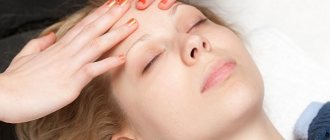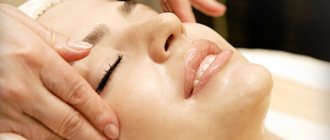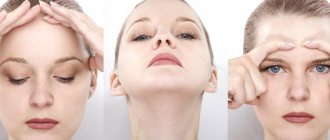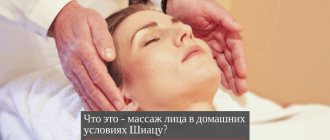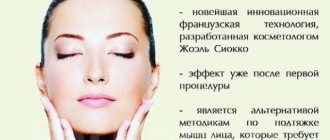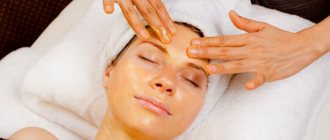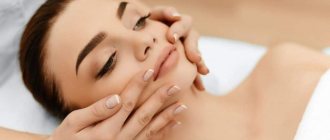Issues discussed in the material:
- Who is suitable for facial massage?
- What effect can be achieved with facial massage?
- At what age can you do facial massage?
- How often can you do a facial massage?
- What procedures can be combined with facial massage?
- What types of facial massage are there?
Facial massage effectively improves skin tone, gets rid of wrinkles, pigmentation and swelling. During this kind of exposure, the nerve endings receive an impulse. The signal then enters the brain, and this leads to positive changes in tissue structure. There are different types of facial massage. Each has its own specific impact. Thanks to one technique, it is possible to tighten and significantly improve the contour of the face, and thanks to another, it is possible to improve the functioning of the sebaceous glands.
Why does facial massage become necessary as you age?
The skin of the face ages under the influence of changes occurring in the body. This process is influenced by the following factors:
- muscle spasms;
- incorrect posture and neck position;
- decrease in the volume of bone structures that occurs with age;
- skin type features;
- influence of the sun;
- facial expressions;
- incorrectly selected type of skin care;
- Lifestyle.
As the body ages, the elasticity of the skin and its tone change. The reason for this is that blood circulation is impaired and the volume of skin structures becomes smaller. Thinning also occurs in the outer layer of the skin, which is accompanied by a decrease in the fat layer.
When exposed to the sun, the skin dries and pigmentation appears. Due to hypertonicity of the facial muscles and poor lymph flow, drooping of the eyebrows and forehead occurs, which is accompanied by the formation of folds on the eyelids. The line of the nasolabial triangle also becomes more noticeable, the facial contour drops, and a flabby double chin appears.
In addition, with age, calcium is washed out of the body and muscle hypertonicity appears, which leads to a decrease in the volume of the skull bones and the formation of sagging and folds.
That is why facial muscle massage is rightfully one of the most important daily skin care procedures. Thanks to it, the texture of the skin improves, it becomes younger and healthier, stimulation processes are launched in the deep layers, cell regeneration begins, muscles relax and return to normal. Thanks to massage, you can get rid of stress and nervous tension.
If you do the procedure regularly, the result will be immediately noticeable - the skin will become younger, the appearance will be transformed.
The benefits of facial massage are that it helps:
- reduce the number of wrinkles and prevent them;
- tighten pores;
- relieve tension;
- carry out a natural facelift;
- rejuvenate the skin at the cellular level;
- increase blood circulation;
- saturate the skin with nourishing ingredients.
Before carrying out the procedure, it is necessary to understand the existing types of facial massage and their features.
Main types of facial massage
The history of facial and body massage goes back to ancient times. It was used for medicinal and cosmetic purposes in Ancient Egypt, Greece, and Rome. In the Middle Ages, during a time of active interest in anatomy, information and scientific substantiation of the basic massage techniques that were used for the face and body appeared.
Basic facial massage techniques.
All movements during the procedure should be made with the fingertips exclusively along the massage lines. At the same time, your touch should be soft. You can lightly rub the skin and stroke it with the back of your hand.
Any procedure must begin and end with light stroking.
The main techniques include:
- stroking;
- trituration;
- tapping;
- pinching;
- kneading.
More effective techniques.
Among the most effective procedures are techniques with a lifting effect. These types of facial massage allow you to achieve the most noticeable results.
A technique that deserves special attention is buccal massage, which has the deepest penetration. Through it, it is possible to train muscles, restore skin tone, returning it to a young, fresh appearance. Another distinctive feature of this type of massage is the need to massage the lines through the oral cavity.
Individual schemes.
When choosing a massage technique, you need to take into account the individual characteristics of each skin type. This will avoid unwanted reactions such as irritation and redness. If the impact on the skin is not varied, the skin and muscles get used to the same impact, which affects the effectiveness of the procedure. For this reason, from time to time it is necessary for one massage technique to be replaced by another.
In addition to massage techniques in cosmetology, there are other ways to maintain and restore facial beauty: therapeutic methods, hardware techniques, as well as injections of drugs that are administered intramuscularly and subcutaneously. At the same time, new methods aimed at effective skin rejuvenation are regularly introduced.
And although cosmetology and aesthetic medicine is developing very quickly and rapidly, the relevance of manual massage does not decrease at all. It is used not only as an independent procedure, but also as part of complex programs.
Thanks to a properly selected facial massage, its type and technique, it is possible to:
- stimulate blood circulation;
- activate metabolic processes occurring in the body, saturate tissues with oxygen and nutrients, remove toxins in a shorter time;
- strengthen facial muscles;
- increase skin firmness and elasticity;
- open pores and increase penetration of cosmetics.
Recommended reading:
- What not to do after eyelash extensions
- Which eyelash extension to choose for yourself
- Eyelash care: advice from professionals
Duration of the procedure
The duration of one session is 10-15 minutes. It is advisable to perform at least 10 procedures sequentially. If the massage is performed correctly along the massage lines, the result will be healthy, toned, ruddy skin.
After the full course, your facial skin should be given a rest period of more than two months. During the massage course, it is not recommended to drink alcohol, smoke, or eat salty or very fatty foods. Otherwise, the vessels will narrow, blood circulation will deteriorate, and the face will swell.
After each massage session, you need to remove any remaining oil with a napkin or cotton pad. You can additionally apply a mask or nourishing cream to dry skin.
The most popular types of facial massage and their descriptions
Classic facial massage.
This type of massage is one of the most popular and in demand. Thanks to this technique, it is possible to increase skin tone, improve the appearance and complexion.
The massage technique includes several techniques that are used in turn: stroking, rubbing, kneading, vibration. Massage movements should be smooth and sliding, they must be done with your fingertips. In this case, special attention must be paid to stroking and rubbing the skin of the face.
During the procedure, you need to use a massage cream or facial oil.
All movements must be performed exclusively along massage lines in the direction from the center to the peripheral part of the face:
- from the chin to the earlobes, then down to the sides of the neck;
- from the corners of the mouth to the lower third of the auricle;
- from the wings of the nose to the temples;
- from the forehead to the upper third of the auricle;
- from the outer part of the eye to the inner along the lower eyelid, as well as from the inner edge of the eye to the outer along the upper eyelid.
The forehead should be massaged additionally, making movements in the middle and along the hairline.
Similar techniques are used when working on the neck and décolleté area. Movements should be directed along the lymph flow, towards the axillary, supraclavicular and subclavian lymph nodes.
During a classic facial massage, the master tries not to take his hands off the client’s skin.
One session usually lasts about 15–20 minutes and should be done every other day. A total of 10–20 procedures are needed.
Classic massage is prescribed to prevent age-related changes in facial skin, as well as for:
- thinning of the skin;
- formation of facial wrinkles;
- loose skin;
- swelling;
- dull, “tired” skin;
- dryness;
- decreased skin tone.
You should not have a massage if:
- there is some kind of infectious process going on in the body;
- there are inflammations and abrasions on the skin;
- have blood diseases;
- increased body temperature;
- have cancer;
- the client suffers from arterial hypertension;
- there are chronic diseases in the acute stage.
Anyone can choose a classic type of cosmetic facial massage, regardless of gender and age. After completing the entire massage course, the face becomes fresher and more hydrated, the number of wrinkles is reduced, and folds become less noticeable. In addition, skin elasticity increases. But don’t expect too noticeable lifting effect. It will not be possible to achieve this with a classic massage. This requires the use of other methods, including myofascial and plastic facial massage, bioreinforcement with hyaluronic acid, and photorejuvenation.
Massotherapy.
Contraindications
Facial massage should not be performed in case of colds, as well as in case of various inflammatory reactions on the skin - acne, rosacea, including herpes and injuries (abrasions, scratches). You can start massage after the exacerbation has passed, or after the onset of remission.
For rosacea, preference is given to lighter lymphatic drainage massage techniques. As for botulinum toxin injections and fillers, massage can begin three weeks after the administration of the drugs.
New types of facial massage
Pinch massage.
The technique of this type of massage includes movements with kneading, vibration, deep pinching and stroking. This procedure must be performed using talcum powder. Massage is indicated for scars, comedones, problematic, oily skin and as a procedure that follows cleansing. The thickness of the skin determines the time allotted for the session. If the skin is thin, it will take less time. As soon as the first redness appears, the massage must be completed. Those with normal skin type can easily tolerate the procedure.
The point of this type of massage is to pinch the sebaceous glands and normalize their functioning and improve blood circulation. The occurrence of painful sensations is possible. The upper layers of the epidermis and subcutaneous tissue also have a positive effect. In order to achieve a good result, at least 10 procedures will be required. At the very beginning, massage should be done every day, and after that two or three times a week. Repeating the course is allowed after a month.
Asahi (Japanese).
This technique has its own name - ZOGAN (Tsogan, Zogan) massage, translated as “creating a face.” This ancient technique was given a second life by cosmetologist Hiroshi Hisashi, and it gained great popularity after the book by Yukuko Tanaka.
The distinctive features of the Japanese technique are aggressiveness and radicalism, since all movements are performed with considerable effort, working not only the epidermis, but also the deep muscle layers and bone tissue. Thanks to the Zogan technique, it is possible to stimulate the lymph nodes and blood vessels, remove excess fluid, remove toxins, and nourish the tissues.
Due to such a deep impact, the face comes to life as if from the inside. By correcting the position of the bones, facial features become more attractive. Due to good treatment of areas with fat deposits on the chin and cheeks, the oval is corrected. The load placed on the muscles helps tone and tighten them. Finally, thanks to increased blood supply and lymphatic drainage, the skin looks healthier and fresher.
Only until March 6
Win guaranteed gifts in March! Discounts on services, photo sessions, as well as the opportunity to pick up the main prize - IPHONE 13 PRO
The effect of Japanese massage on lymphatic drainage is obvious, so there is no need to do it if you have ENT diseases, since there is a risk of spreading the infection through the lymph flow throughout the body. This procedure is not suitable for people with naturally sunken cheeks and a thin layer of fat. Due to the massage, their face will look thinner, and due to intense muscle work, rosacea may occur.
Shiatsu.
The fundamental distinguishing feature of this type of massage is the absence of smoothing techniques in the technique. When performing a Shiatsu massage, the master presses with his fingertips on certain areas of the face. During this effect, energy flows and metabolic processes are activated, epidermal cells receive the necessary nutrition, which helps remove swelling, make the skin color more even and restore its elasticity.
The technique of performing Shiatsu massage, at first glance, is very simple. But if you fall into the hands of an inexperienced master, the consequences may not be very pleasant. Possible pinched nerve endings, muscle damage, internal hematomas.
Buccal.
This type of facial massage also has a second name - sublingual. In this technique, kneading is done through an open mouth. The author of this technique was Joelle Siocco. She went down in the history of French cosmetology as a great professional in her field and an ardent opponent of plastic surgery.
During the process of such a massage, a specialist captures a certain area of the lips, cheeks, and chin from both sides at once, and then performs intense massaging movements of every inch. At the same time, the muscles are slightly stretched and kneaded. At the end of the session, the client usually experiences slight discomfort, which is similar to muscle pain after strength training.
With such deep treatment, it is possible to restore the skin’s former elasticity and make the contour of the lower part of the face clearer. Using this technique, you can significantly reduce the severity of even the most obvious age-related changes. This type of facial massage is especially effective when there is a need to eliminate nasolabial folds. In addition, in some cases, buccal massage is used to develop atrophied muscles in people who have suffered a stroke.
Only a professional who is well versed in anatomy, structural features of muscles, nerve bundles, and blood vessels can perform such a facial massage.
The main disadvantage of this technique is that when performing it, you cannot use the entire face.
Vacuum.
Technique of the procedure
Cream, oil or talc is applied to the skin of the face and neck 10 minutes before the procedure. At the same time, the massage therapist’s fingers move along certain lines strictly clockwise - it is in this direction that the blood flows.
Basic massage techniques:
- kneading and tapping;
- stroking for 5 minutes;
- vibrating movements;
- at the end of the massage - gentle stroking.
When performing a massage, the delicate area around the eyes is not affected. If skin imperfections are very pronounced, the use of special equipment may be required.
Movements should be careful and delicate - even when performing a pinch massage. Do not apply excessive pressure, stretch or squeeze the skin. Massage should not hurt. The duration of the procedure is approximately 15 minutes. To achieve a lasting effect, you need to complete a full course of massage, which consists of 10 visits.
Duration of the procedure
30-60 minutes
Duration of effect
up to 6 months
Course duration
4-6 sessions
Sign up for the procedure right now
Frequently asked questions about facial massage
- At what age can you do facial massage?
- How often can you do a facial massage?
- How long does the effect last?
- How long should the massage last?
- What should be the schedule of procedures.
This is a universal procedure that helps not only with regeneration, but also with skin health. Representatives of the fair sex can start it at any age, provided there are no medical contraindications. However, most often, up to the age of 25, girls’ skin is characterized by elasticity and tone, which begins to decrease after this age. With the onset of 30 years, the use of massage procedures should become a regular rejuvenation procedure.
It depends on your skin type and age-related changes. It is optimal to conduct courses 2 or 3 times a year. This is quite enough to consolidate the effect. If you have sensitive skin, the number of sessions per week should be two or three, and if your skin is normal, then three to four times will be enough.
The effect achieved after a deep massage procedure can be either temporary or long-lasting. If you massage once, microcirculation will increase, swelling will go away and your complexion will improve. However, the result will not be permanent, since this requires doing the procedure constantly. It is optimal to choose a course consisting of 10–15 sessions.
How long the procedure will take depends on the technique used. An interval of 30–50 minutes should be observed. During this time period, the muscles will be able to relax and become more active.
In order to create a plan for massage sessions, it is necessary to take into account a number of individual characteristics, including skin type and age:
- The procedure is indicated from the age of 25, when there is a need for additional care for the skin and muscles of the face. 10 sessions should be performed once a year;
- after 30 years, the massage complex can be repeated twice a year, performing 12–15 sessions;
- After 35 years, the body's need for care increases. It is advisable to increase the frequency of sessions to 3 times a year, and the number of procedures should increase to 15–20.
Combination of facial massage and other treatments
Cosmetical tools.
With any type of manual facial massage, blood circulation processes are activated and pores are opened. As a result, the skin becomes more sensitive to the cosmetics used, which must be applied after the procedure.
It’s good when both the massage technique and the cream used correspond to the same goal. For example, plastic facial massage, in the case of wrinkles and reduced skin turgor, must be completed with the application of an anti-aging serum and a lifting mask.
Hardware cosmetology.
To obtain the maximum effect, hardware cosmetology must be used together with lymphatic drainage facial massage, myostimulation, classical massage and microcurrents.
